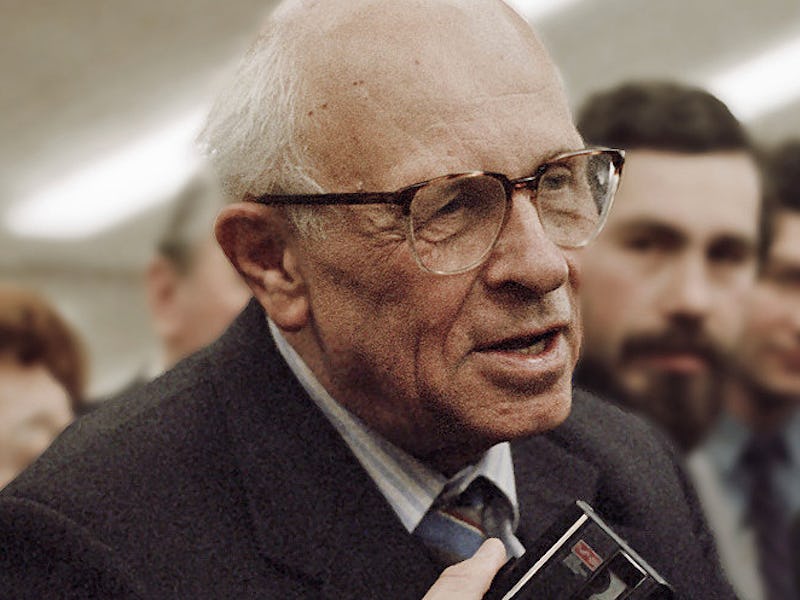How Soviet Bomb Maker Andrei Sakharov Inspired Starshot's Search for Alien Life
Yuri Milner, the Russian billionaire financing Breakthrough Starshot, lives in the shadow of Soviet physicist Andrei Sakharov.

Yesterday, Yuri Milner, Stephen Hawking, and a panel of theoretical physicists announced Breakthrough Starshot, an initiative to reach our neighboring star system, Alpha Centauri with a fleet of nanocrafts. The spacecraft in question, compact smartphone-sized ships with light sails, are relatively easy to understand. The launch system is relatively easy to understand. Even the vector of the voyage is fairly simple. But the reason why Russian businessman Yuri Milner has decided to spend his money sending sensors to the “Centaur’s Foot” is a bit more obscure — but hardly indecipherable. To get Milner, one simply has to understand his mentor, the nuclear physicist Andrei Sakharov.
Long before he was thinking about sending nanocrafts or messages far into space, though, Milner was a Ph.D. student who befriended the 1975 Nobel Peace Prize Winner Sakharov while working at the Russian Academy of Sciences.
Sakharov, a Russian nuclear physicist well-known for his role in developing the Soviet Union’s thermonuclear weapons and later for his activism surrounding disarmament and human rights, was deeply influential on Milner, particularly in regards to how the young man thought about the future. Sakharov’s manner of thinking may have led to Milner’s successful investing career (he was early to both Facebook and WhatsApp) because the older man insisted on thinking a decade ahead. He was a physicist by training and a futurist by temperament. He was also very, very interested in space — and what we might find if we explored it.
In his 1975 Nobel lecture, Sakharov spoke of the dangers facing humankind, the possibility of other civilizations in “infinite space” and the impact this possibility can and should have on life on Earth:
“In infinite space many civilizations are bound to exist, among them civilizations that are also wiser and more “successful” than ours … Yet this should not minimize our sacred endeavors in this world of ours, where, like faint glimmers of light in the dark, we have emerged for a moment from the nothingness of dark unconsciousness of material existence. We must make good the demands of reason and create a life worthy of ourselves and of the goals we only dimly perceive.”
Sakharov fully believed that there was life beyond our planet. In 2016, this idea is far from radical within the scientific community, but, in 1975, Sakharov’s ideas were likely met with skepticism. This was particularly true in America, where the Cold War had convinced the government to treat UFOs and those who claimed to have seen them as a threat. In Russia, Sakharov wasn’t considered a crank, and it’s critical to understand that Milner is, well, Russian, and seemingly possessed of more romantic ideas about space because of that. (It’s worth noting in passing that Milner’s artist wife received some critical praise in Moscow for a photo series in which she altered images of vaginas to look like galaxies.)
Breakthrough Starshot isn’t Milner’s first stab at financing the search for extraterrestrial life. In 2015, Milner also introduced Breakthrough Listen and Breakthrough Message, both of which take hard aim at moving the search for life up on our global list of cosmological priorities. Each of the Breakthrough Initiatives are focused on answering a simple, formative question that was central to Sakharov’s lecture more than a quarter century ago: “Are we alone?”
Though Sakharov died in 1989, long before Milner introduced the world to the Breakthrough Initiatives, his impact on Milner and, by extension, our efforts at exploring the universe beyond our own cosmic backyard, is evident. Perhaps once Breakthrough Starshots nanocrafts reach Alpha Centauri, we’ll look back again on Sakharov’s Nobel lecture from 1975 and be reminded of where the initiative began: with a Russian physicist turned human rights activist and Ph.D. student who adopted his penchant for thinking critically about the future.